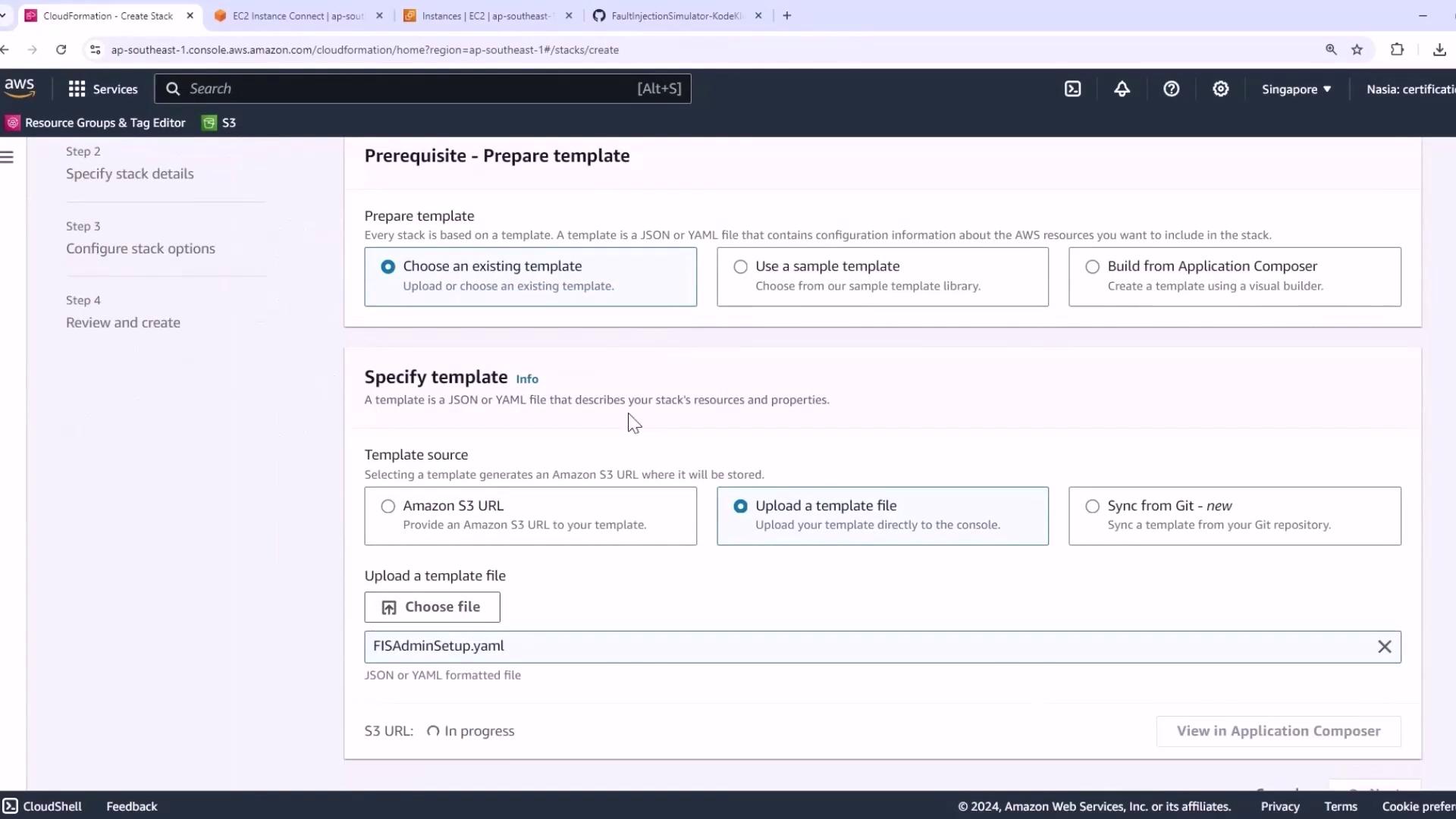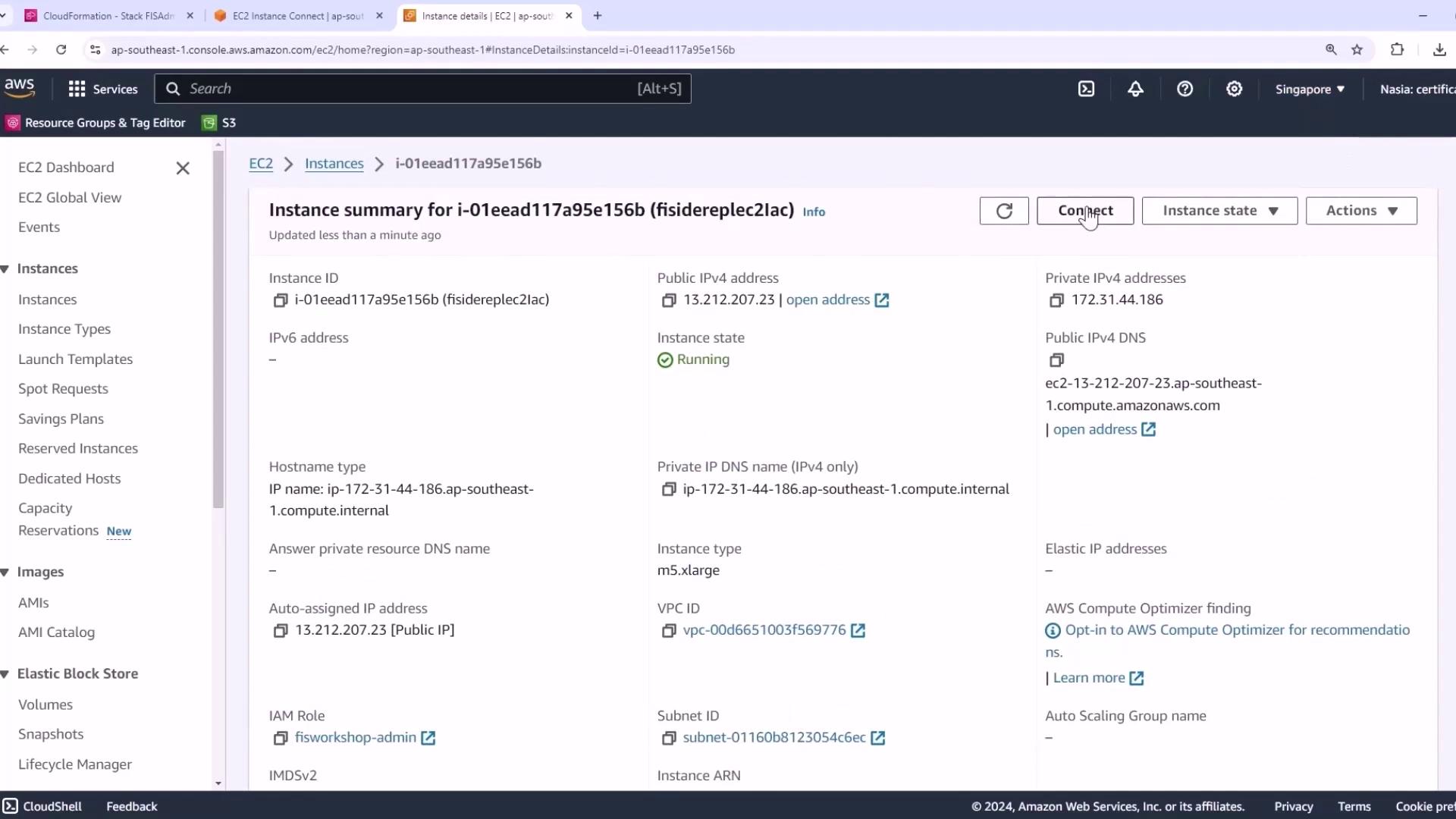Chaos Engineering
Introduction to Real life Application
Demo Cloud Formation Deployment
Previously, we deployed our application build environment on EC2 using the AWS Console. In this tutorial, we’ll automate that process with AWS CloudFormation. The template (FISAdminSetup.yaml) is in the GitHub repo (see README).
CloudFormation Template Overview
This template:
- Defines two parameters:
- DefaultVPCId: Your default VPC ID
- LatestAl2023AmiId: Latest Amazon Linux 2023 AMI ID (kernel 6.1)
- Creates an IAM role (
fisworkshop-admin) for EC2 & Systems Manager - Provisions an EC2 instance with security group, instance profile, and user data
AWSTemplateFormatVersion: "2010-09-09"
Parameters:
DefaultVPCId:
Type: AWS::EC2::VPC::Id
Description: Default VPC ID for the region
LatestAl2023AmiId:
Type: AWS::SSM::Parameter::Value<AWS::EC2::Image::Id>
Description: Latest Amazon Linux 2023 AMI ID (kernel 6.1)
Default: "/aws/service/ami-amazon-linux-latest/al2023-amazon-linux-latest-6-x86_64"
Resources:
FISWorkshopAdminRole:
Type: AWS::IAM::Role
Properties:
RoleName: fisworkshop-admin
AssumeRolePolicyDocument:
Version: "2012-10-17"
Statement:
- Effect: Allow
Principal:
Service:
- ec2.amazonaws.com
- ssm.amazonaws.com
FISAdminEC2Instance:
Type: AWS::EC2::Instance
DependsOn: FISWorkshopAdminInstanceProfile
Properties:
InstanceType: m5.xlarge
ImageId: !Ref LatestAl2023AmiId
KeyName: !Ref FISWorkshopKeyPair
SecurityGroupIds:
- !Ref FISWorkshopSecurityGroup
IamInstanceProfile: !Ref FISWorkshopAdminInstanceProfile
UserData:
Fn::Base64: !Sub |
#!/bin/bash
yum update -y
curl -fsSL https://rpm.nodesource.com/setup_current.x | bash -
yum install -y nodejs git docker
systemctl start docker && systemctl enable docker
npm install -g aws-cdk --force
# Install kubectl
curl -o kubectl https://s3.us-west-2.amazonaws.com/amazon-eks/1.29.0/bin/linux/amd64/kubectl
chmod +x kubectl && mv kubectl /usr/local/bin/
# Install Helm
curl --location "https://get.helm.sh/helm-v3.1.3-linux-amd64.tar.gz" | tar xz -C /tmp
mv /tmp/linux-amd64/helm /usr/local/bin/helm
# Install eksctl
curl --location "https://github.com/weaveworks/eksctl/releases/latest/download/eksctl_$(uname -s)_amd64.tar.gz" | tar xz -C /tmp
mv /tmp/eksctl /usr/local/bin/eksctl
Note
All dependencies (Node.js, Docker, AWS CDK, kubectl, Helm, eksctl) are installed automatically via EC2 user data.
Deploying the CloudFormation Stack
- Open the CloudFormation console.
- Click Create stack > With new resources (standard).
- Upload the
FISAdminSetup.yamltemplate. - Click Next.

- Configure stack details:
- Stack name:
FIS-Admin-Setup - DefaultVPCId: Select your default VPC
- LatestAl2023AmiId: Confirm or override the AMI
- Stack name:
- Click Create stack and wait until the status is
CREATE_COMPLETE.
Provisioned Resources
| Resource | Description |
|---|---|
| EC2 Key Pair | SSH key for instance access |
| IAM Role & InstanceProfile | EC2 & Systems Manager permissions |
| Security Group | Network rules for the EC2 instance |
| EC2 Instance | m5.xlarge instance with all tools installed |
Verify the EC2 instance in the console:

Connect & Verify Installed Tools
SSH into the instance and run:
git version # e.g., git version 2.40.1
node --version # Node.js
docker --version # Docker
cdk --version # AWS CDK
kubectl version --client
helm version
eksctl version
Prepare the FIS Workshop Environment
Clone the AWS Fault Injection Simulator workshop:
mkdir -p ~/environment/workshopfiles
git clone https://github.com/aws-samples/aws-fault-injection-simulator-workshop-v2.git \
~/environment/workshopfiles/fis-workshop
Verify AWS Region & IAM Role
export AWS_REGION=$(curl -s 169.254.169.254/latest/meta-data/placement/region)
echo "AWS_REGION is $AWS_REGION"
aws sts get-caller-identity --query Arn \
| grep fisworkshop-admin -q \
&& echo "IAM role is valid." \
|| echo "IAM role NOT valid. Terminate and retry."
Warning
If the IAM role validation fails, stop here. Ensure fisworkshop-admin is correctly attached before proceeding.
Install Dependencies & Bootstrap CDK
cd ~/environment/workshopfiles/fis-workshop/PetAdoptions/cdk/pet_stack
npm install
npm audit fix
cdk bootstrap
Deploy the FIS Workshop Stacks
Build your service Docker image:
docker build --platform=linux/amd64 -t my-image:latest .Deploy the main FIS CDK stack (replace with your ARNs):
cdk deploy FisStackAsg \ --context admin_role=$EKS_ADMIN_ARN \ --context dashboard_role_arn=$CONSOLE_ROLE_ARN \ --require-approval neverRetrieve the Petstore site URL:
export MYSITE=$(aws ssm get-parameter --name '/petstore/petsiteurl' \ | jq -r .Parameter.Value \ | tr '[:upper:]' '[:lower:]' \ | cut -f 3 -d '/') echo "Petstore URL: $MYSITE"Deploy FIS serverless & observability components (may take up to 30 minutes).
Your CloudFormation-based environment is now ready for the AWS Fault Injection Simulator workshop!
References
Watch Video
Watch video content